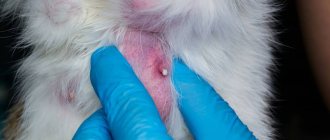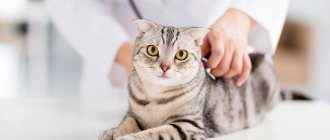Recommended Medicines
- Fact 1:
The disease has many names, but none of them change the essence - it is a deadly infection - Fact 2:
The older the animal, the more successfully it fights the disease, and the symptoms of distemper are weaker. - Fact 3:
Vitafel. Immunoglobulin serum. Affects the causative agent of plague - Fact 4:
Fosprenil. Injection solution based on pine needle extract
For every pet owner, his illness is a disaster. But the plague is a doubly tragedy. You can never predict how it will turn out for a small patient, because the danger of the disease is difficult to compare with any other infections. And the outcome can be the saddest, even with good medical care.
And all because a person can only alleviate the suffering of an animal, reduce pain, and support the affected organs. But the animal will have to fight the dangerous disease on its own. And it depends only on the strength of the body whether the pet will be able to overcome the infection or will go out like a candle, sometimes literally within a day.
How does a cat become infected with distemper?
A cat does not need direct contact with a sick animal to become infected!
Cats are infected from sick animals, but direct contact is not necessary.
The virus is released into the external environment along with vomit and feces, which can land on the owner’s shoes and be carried into the apartment. That is why veterinarians recommend vaccinating cats that live exclusively in an apartment without access to the outside.
The cat owner can bring the source of distemper on shoes from the street.
The risk of infection is small, but it is easier to prevent the disease than to deal with its severe consequences , because feline panleukopenia (like other viral diseases of cats) can be fatal.
Effect of ethanol
There is a myth that ethanol is a natural metabolite. It is not true. There is not a single reaction that occurs inside a living organism that would result in the production of ethanol. At the same time, there are many bacteria in the intestines whose task is to produce vitamins, process fiber, and some of them produce ethanol (about 3 grams per day). However, there are no such microbes inside the cat’s intestines; they exist only in the gastrointestinal tract of humans and other omnivores and herbivores.
Ethanol is a neurotoxic poison, a carcinogen and a drug that suppresses the activity of the central nervous system. Suppression of the nervous system is possible up to coma and death. The lethal dose is 5-8 ml of alcohol per kilogram of weight, that is, for a cat this is about 3-4 tablespoons of 40% vodka (it contains 20 ml) or teaspoons of pure ethanol.
Stages of intoxication with increasing dose
When consuming small doses, the “reward system” is activated, the active substance of which is dopamine. The purpose of these reactions is to motivate the animal to perform certain actions: sex, successful hunting, victory over an opponent in a territorial fight. However, you should not think that you can give your cat alcohol to “relax” it, since the “useful” dose is too small - literally 0.1 ml of ethanol or 0.3 ml of vodka. It is inconvenient to administer such an amount of alcohol even through a syringe.
A further increase in the dose depresses the activity of the central nervous system; every person has seen all these aspects more than once or even experienced it on himself:
- the brain’s ability to concentrate on various thoughts decreases, only one idea remains (usually not a good one);
- coordination of movements is impaired;
- the hunger center is stimulated, that is, the animal’s appetite increases;
- the last stage is narcotic dreamless sleep.
Sobering up
It begins simultaneously with intoxication, but since this process is slow, its result is felt only after stopping drinking alcohol.
Sobering up is directly related to the destruction of ethanol.
It goes in 2 stages:
- Decomposition of ethanol to acetaldehyde . Several systems in the body are responsible for this; the transformation of alcohol occurs both inside cells and in the blood, liver and intercellular fluid.
- Decomposition to acetic acid . This stage of decomposition takes place exclusively inside the cells, which is why the speed of this stage is greatly inhibited.
It is acetaldehyde that is the main cause of all the unpleasant sensations of a hangover. Moreover, the second stage takes much longer than the first. As a result, due to the difference in speed, acetaldehyde accumulates, which is not destroyed immediately, resulting in a hangover.
Symptoms and signs of panleukopenia (feline distemper)
The panleukopenia virus, like most other viruses, has its “favorite” places - in this case, the lymphatic cells and tissues that cats have in the intestines, bone marrow and the lymphatic system itself (nodes and vessels).
With plague, secondary infections may appear, for example, bacterial (she is in the photo)
It is these places that distemper affects, causing serious harm to the cat’s immune system. The body becomes unable to sufficiently protect the cat from surrounding infectious agents, and other problems may be superimposed on the disease - concomitant infections, secondary infections caused by a decrease in the body’s supporting ability and the “overgrowth” of the body’s natural microflora in the ears, intestines and other places where they live.
Dormant infections
With a decrease in the level of protection, dormant infections can “wake up” - most cats are carriers of viruses that do not make themselves known until the cat’s body is weakened and favorable conditions are created for their activity.
Complication of herpes in a cat, which is caused by distemper
The severity of the symptoms and the severity of the animal’s condition depend on many factors : age, conditions of detention, the strength of the immune system, the strength of the pathogen itself.
- specific symptoms of the disease appear : high fever, depression, refusal to feed.
- Specific symptoms of the disease are signs of damage to the gastrointestinal tract. These signs include vomiting and diarrhea. Vomit may contain mucus and blood. The stool becomes loose and foul-smelling, and blood clots may also appear. The color of the urine changes and becomes dark or orange.
Sick cats instinctively seek shelter
Sick cats instinctively seek shelter - they will hide in hard-to-reach places. They may often want to lie down on something cold; this behavior is associated with high fever.
Antiviral complex
Vitafel . Immunoglobulin serum. It affects the causative agent of panleukopenia in animals at any age, incl. during pregnancy and lactation. There are no contraindications or side effects. The product can be combined with any other medications. The drug is administered subcutaneously, twice per course (once a day) at the rate of 1 ml for a pet weighing up to 10 kg, 2 ml for an animal over 10 kg.
Fosprenil . Injection solution based on pine needle extract. It is used simultaneously with other symptomatic remedies, which gives the best effect. Placed subcutaneously, dose calculation: 0.5 ml per 5 kg of weight, if the pet weighs less than 1 kg - 0.2 ml. Scheme:
- 1-2 days – 2 times;
- from 3 to 10 days – 3 times;
- from 11 to 13 days – 2 times;
- 14-15 days – 1 time.
Enterostat . 1 injection once weekly. For every kg of weight – 20 mg of the drug.
In addition, other therapeutic measures are carried out in parallel:
- hyperimmune serum - in the first few days of the disease;
- vitamin complex to strengthen the immune system;
- glucose intravenously or subcutaneously (5% solution) to maintain the body;
- corticosteroid drugs to relieve shock;
- salt solutions drip to relieve intoxication;
- antiemetic to prevent dehydration.
If there is a concomitant infection, then antibacterial drugs are used.
The dangers of treating plague at home
Precious time for your pet is lost while waiting for a miraculous healing and during self-medication.
Treatment with vodka and folk remedies
Treatment of feline distemper with vodka is NOT ALLOWED!
When carrying out therapy with the same vodka, or doing nothing at all in the hope that it will “fall off on its own,” you cannot know exactly what is happening in the animal’s body - this is not visible to the “naked eye,” and the cat itself will not say “enough, I’m getting worse.” .
And it definitely gets worse, because the animal does not receive any of the medications it needs, the virus continues to destroy the body’s lymphatic tissues, the immune system continues to suffer, and the cat’s immunity is increasingly suppressed.
Secondary microflora is layered, further worsening the condition of the animal, the epithelium of the gastrointestinal tract is literally washed away along with diarrhea, the gastric mucosa suffers from constant vomiting (and possibly from vodka).
To prevent all these terrible processes, which may ultimately lead to death (and often very quickly), it is necessary to contact a specialist as soon as possible after identifying the symptoms of the disease.
Consequences after the disease
Successful recovery does not guarantee that the animal will not have health problems in the future. After an illness, there is a high probability of developing chronic inflammation of internal organs and systems. However, it’s up to the cat’s owner to do everything, because it’s possible to prevent the problem with three simple steps:
- Timely vaccination;
- Preventive examination at a veterinary clinic, especially if any symptoms are observed;
- Careful care for your pet: good nutrition and comfortable living conditions.
Proper treatment for a cat
What treatment does a cat with panleukopenia need? First of all, you should not listen to any advice about vodka or other nonsense. You need to think logically and try to understand why vodka cannot help a cat with panleukopenia in any way, and may even harm it.
- There are no specific medicines against viral diseases, both cats and dogs, people and other species of animals, respectively, and vodka does not apply to such medicines.
- The panleukopenia virus affects the gastrointestinal tract, that is, pouring vodka into a cat is the same as pouring vodka into a person with erosive gastroduodenitis.
- Vodka can simply poison an animal.
No matter how many stories there are on the Internet about fabulous healing of animals from distemper (both dogs and cats) with the help of vodka, eggs and the like, do not follow these tips . Do people treat any disease with vodka? So where did this wild method of treating cats come from? Vodka is not a medicine, it is alcohol, and it cannot be useful to the animal. And you need to remember - sometimes an animal gets better not because of it, but in spite of it.
Establishing diagnosis
You cannot begin any treatment, first of all, without a diagnosis by a specialist and a prescription based on the diagnosis. Only a doctor can correctly assess the animal’s condition, determine what therapy it needs and correctly calculate all dosages of drugs.
As mentioned above, there are no specific drugs against viruses, therefore panleukopenia, like any other viral infection, is treated symptomatically.
Treatment usually includes the following:
- If an animal vomits and has diarrhea , dehydration will be observed in any case (an analogy can be drawn with a person), which means that it needs infusion therapy - infusion of solutions through a venous catheter.
- Refusal to feed is another reason why drip administration of drugs is necessary.
- Antiemetic drugs are used to stop vomiting .
- Gastroprotectors are also prescribed to protect the gastric mucosa.
- To maintain the body and activate its defenses, serums, vitamins , and metabolic stimulants can be used.
- To reduce body temperature, drugs from the NSAID group (non-steroidal anti-inflammatory drugs) are used, which act on three fronts - they reduce temperature, reduce inflammation and relieve pain. Sometimes opioids are used instead of NSAIDs - they have a calming effect on cats, effectively relieve pain, and allow them to relax.
- Antibiotics do not work against viruses , but they have an anti-inflammatory effect and prevent the development of secondary bacterial infection against the background of a decrease in the body's defenses.
Hospital
Animals in serious condition are recommended to be left in an inpatient clinic (something akin to hospitalization) for constant monitoring of the condition, regular temperature measurements, assessment of dynamics, administration of drugs by drip (this can hardly be done at home), adjustment of the prescription if necessary - adding drugs or canceling them .
Summarize
Although the nature of the article is somewhat sarcastic and partly cynical, in fact this is the author’s defensive reaction to all the monstrous nonsense that people do to themselves and their pets.
I repeat that this is the 21st century, people have learned methods of artificial insemination, are transplanting organs, creating bionic limbs, Mars is being colonized, in the end, and there is absolutely no reason to turn to “old-fashioned” methods and all sorts of charlatan theories. Veterinary medicine is a high-tech and highly scientific field that is constantly developing and has stepped far forward since the days of rural farriers and scarce garlic-vodka treatment!
Be wise and merciful, because you are responsible for the life and health of your pet.
KotoDigest Thank you for subscribing, check your inbox: you should receive an email asking you to confirm your subscription
Reviews
The opinions of dog owners differ, but they confirm the fact that everything depends on the animal. Moreover, some veterinarians resort to this popular method and are right. Someone vehemently opposes treating their four-legged friends with this antediluvian method, because they have already lost a dog once.
Someone treated sick puppies this way when antibiotics did not help, and now advises everyone they know to treat distemper exclusively with vodka. Each individual case requires its own treatment methods. The best way is to consult a veterinarian.
Vodka with vanillin against ticks
Ticks are a serious problem for summer residents. To repel ticks and mosquitoes, prepare a tincture of 100 ml of vodka and 2 g of vanillin. The product is infused for a week in a cool, dark place, and then poured into a spray bottle.
Before a walk, the hair on the dog’s belly, withers and paws is sprayed with vanilla tincture. When the fur is dry, the dog can be taken out.
Vanilla tincture does not provide a complete guarantee against insect bites; tar is more effective. But many owners prefer to use vanilla tincture, as it smells more pleasant than tar.
Your mark:
Diagnostics, tests
When making a diagnosis, the veterinarian takes into account the medical history, clinical picture, results of ultrasound, CT, MRI, and the epizootological situation in the region. A number of serological, histological, and complex laboratory studies are carried out. For analysis, blood, stool, urine samples, tear secretions, eye and nasal secretions are taken.
Diagnostics includes PCR analysis, ELISA. Special tests are carried out. Due to the similarity of clinical manifestations, a differential diagnosis is mandatory, which makes it possible to establish an accurate diagnosis if panleukopenia is suspected in cats.
Advantages of the clinic
If you require a full examination and high-quality treatment, welcome to the Health Energy clinic. Here you are waiting:
- experienced specialists who regularly improve their skills to keep abreast of all new trends in the world of medicine;
- modern diagnostic equipment;
- everything necessary for physiotherapy, massage, exercise therapy;
- own day hospital for slow drip administration of medications;
- affordable prices for all services.
If you or your relatives have signs of encephalopathy, do not delay contacting a doctor. The sooner treatment is started, the better the result. Sign up for the Health Energy clinic and let our doctors choose the optimal therapy.
Causes
Damage to nerve cells can occur due to exposure to various pathological factors.
- previous trauma;
- acute or chronic intoxication with salts of heavy metals, narcotic substances, alcohol;
- blood supply disorders (atherosclerosis, arterial hypertension, amyloidosis, etc.);
- infectious diseases (diphtheria, botulism, tetanus and others);
- disorders of the liver or kidneys, accompanied by the accumulation of toxins in the blood;
- disorders of glucose metabolism;
- lack of vitamins (especially group B);
- water retention, lack of sodium in the blood and resulting swelling;
- immunodeficiency states;
- exposure to ionizing radiation;
- hypoxia: insufficient oxygen supply to brain cells.
Vodka for severe exhaustion
People who are very cold drink a glass of vodka to warm up. Under the influence of alcohol, a person begins to sweat. But the dog does not have sweat glands, so it makes no sense to give alcohol to a dog that has fallen into an ice hole or been in the cold for a long time.
However, if the animal is exhausted to such an extent that it is impossible to palpate the veins and give an injection, even experienced veterinarians advise giving a little vodka. Alcohol will speed up your heart rate and blood flow, making it easier for the doctor to find the vein.
General information
Encephalopathy occurs due to metabolic disorders in brain cells. Regardless of the cause, the pathology follows a single scenario. First, there is a decrease in the activity of neurons, then their gradual death. Foci of dystrophy are located throughout the brain, which causes a variety of symptoms.
The damage is irreversible, but with timely consultation with a specialist and quality treatment, the patient’s condition can improve. The remaining intact neurons partially take over the function of the dead cells, and brain function is significantly improved. If the disease was caught at an early stage, the patient retains complete clarity of mind.
Make an appointment
Vodka with garlic as an anthelmintic
Some dog lovers use vodka with garlic as a dewormer. Garlic is an antiparasitic agent. Vodka temporarily immobilizes helminths, so that during bowel movements much more of them come out than usual. Alcohol has no effect on helminth eggs.
But alcohol is very harmful to the liver, so vodka with garlic can be given only in the most extreme cases, when no other deworming agents can be obtained. The product is contraindicated for puppies under one year of age, pregnant and lactating females. Vodka with garlic is much less effective than pharmaceutical preparations.
Kinds
Doctors distinguish between congenital and acquired encephalopathy. The first occurs against the background of an abnormal course of pregnancy or childbirth and, often, develops while the fetus is in the womb. Its signs are detected immediately after birth or appear in the first weeks of life. Neonatologists and pediatricians are involved in the diagnosis and treatment of this condition.
Acquired encephalopathy occurs in adulthood. It is divided into several types depending on the cause of neuronal death:
- post-traumatic: occurs against the background of a traumatic brain injury; often develops within a few years after it and often leads to severe mental disorders;
- toxic: associated with acute or chronic poisoning of the body with alcohol, poisons, narcotic drugs, medicines, salts of heavy metals, etc.; Alcoholic encephalopathy is often distinguished separately within this type;
- metabolic: associated with metabolic disorders in the body; The following subtypes of pathology are distinguished: hepatic: occurs when the liver or biliary tract is damaged;
- uremic: associated with impaired renal function;
- diabetic: is one of the frequent complications of diabetes mellitus, occurs against the background of persistent microcirculation disorders and increased blood viscosity;
- anoxic: develops after clinical death and is associated with oxygen starvation of the brain with the subsequent development of a “metabolic storm”;
- Gaye-Wernicke syndrome: encephalopathy caused by vitamin B1 deficiency;
- pancreatic: is a complication of inflammation of the pancreas;
- hypoglycemic: occurs against the background of a sharp decrease in blood glucose;
- atherosclerotic: develops due to atherosclerosis and thickening of the walls of blood vessels;
Depending on the speed of development of the process, encephalopathy is divided into acute and chronic. The first can develop within a few days or hours, and more often occurs against the background of severe intoxication, trauma, or an infectious process. The chronic process can last for years or decades.










